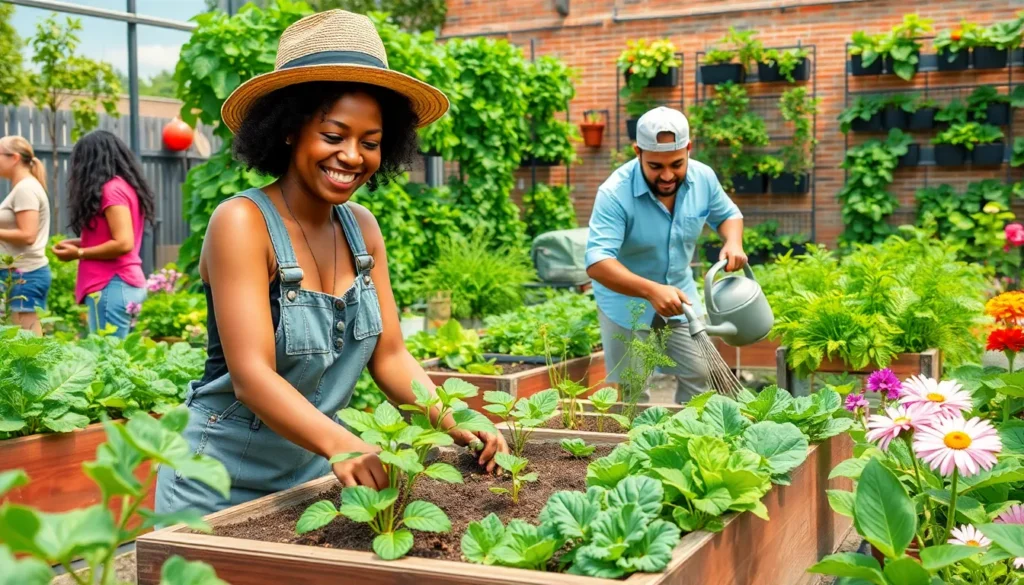In a world where plastic straws seem to be the enemy and climate change feels like a bad sci-fi movie, sustainable living innovations are popping up faster than you can say “eco-friendly.” These groundbreaking ideas are not just saving the planet; they’re making green living a whole lot cooler. From solar-powered gadgets that make you feel like a superhero to compostable products that won’t make your trash can smell like a science experiment, there’s a wave of creativity transforming how we live.
Table of Contents
ToggleOverview Of Sustainable Living Innovations
Sustainable living innovations address urgent environmental challenges with practical solutions. Solar-powered gadgets provide renewable energy options for everyday tasks, reducing reliance on fossil fuels. Compostable products, made from natural materials, decompose efficiently, minimizing waste and pollution. These innovations promote eco-friendly living while enhancing lifestyle aesthetics.
Urban gardening technologies, such as vertical gardens and hydroponics, enable individuals to grow food in limited spaces. Water-saving devices help conserve this precious resource in households, reducing overall consumption and cost. Smart home systems optimize energy usage by controlling HVAC and lighting based on occupancy, making homes more efficient.
Innovative materials, like bio-based plastics and recycled textiles, replace conventional substances, lowering environmental impact. Wildlife-friendly architectural designs encourage biodiversity by integrating green rooftops and natural habitats into urban environments. Electric vehicles, equipped with advanced battery technologies, offer sustainable transportation alternatives, significantly lowering greenhouse gas emissions.
Bicycle-sharing programs promote cleaner commuting options, while sustainable fashion initiatives prioritize ethical sourcing and production. Zero-waste lifestyle practices urge individuals to minimize waste through responsible consumption and recycling. These various sustainable living innovations exemplify collective efforts to create a healthier planet, fostering community engagement and awareness.
Through these developments, a more sustainable future becomes attainable. Individuals embrace innovations that align with their values, creating a ripple effect throughout society. By adopting these practices, everyone contributes to the mission of environmental stewardship.
Technological Advancements

Sustainable living thrives on technological advancements that promote eco-friendliness and efficiency. Innovations in smart home devices and renewable energy solutions lead the charge in transforming lifestyle choices.
Smart Home Devices
Smart home devices enhance energy efficiency and reduce waste. They automate lighting and heating, allowing for customized energy management. Smart thermostats automatically adjust temperatures based on occupancy, saving an average of 10 to 15 percent on energy bills. Intelligent appliances monitor energy usage, enabling users to identify high-consumption items. Connected water monitoring systems detect leaks, minimizing water waste. These devices not only create convenience but also foster sustainable habits in daily routines.
Renewable Energy Solutions
Renewable energy solutions revolutionize how individuals approach energy consumption. Solar panels harness sunlight, providing clean electricity with the potential to power homes for decades. Wind turbines efficiently convert wind energy, offering a substantial alternative in many regions. Battery storage systems store excess energy for use during cloudy or calm periods, promoting reliability. Incentives often exist for installing renewable energy systems, making them financially viable. Collectively, these advancements pave the way for a more sustainable energy future.
Eco-Friendly Practices
Eco-friendly practices play a crucial role in sustainable living by promoting resource conservation and reducing waste. Individuals can adopt various methods to contribute positively to the environment.
Zero Waste Lifestyle
A zero waste lifestyle focuses on minimizing waste generation. Reusable products like water bottles and shopping bags replace single-use items, significantly cutting down on landfill contributions. Composting organic waste transforms food scraps into nutrient-rich soil, reducing garbage output. Bulk shopping allows consumers to purchase goods without excess packaging, promoting a more sustainable approach. Many people embrace upcycling, creatively repurposing items instead of discarding them. By prioritizing these practices, individuals demonstrate a commitment to environmental stewardship.
Sustainable Transportation
Sustainable transportation encompasses eco-friendly commuting options. Electric vehicles significantly reduce greenhouse gas emissions compared to traditional gasoline-powered cars. Public transit systems such as buses and trains decrease the number of vehicles on the road, minimizing traffic congestion and air pollution. Bicycling serves as a low-impact alternative, promoting fitness while lowering carbon footprints. Carpooling and ride-sharing services offer opportunities to share rides, maximizing vehicle use. By exploring these transportation methods, individuals contribute to a cleaner, healthier planet.
Community Initiatives
Community initiatives play a pivotal role in promoting sustainable living. Various projects foster environmental awareness and engage local residents.
Urban Gardening Projects
Urban gardening projects transform city spaces into green havens. Residents create vertical gardens, rooftop farms, and community plots that allow them to cultivate their own food. These initiatives not only provide fresh produce but also promote biodiversity and improve air quality. Participating in local gardening projects increases community cohesion, encouraging neighbors to work together and share resources. Educational workshops often accompany these initiatives, teaching sustainable practices like composting and rainwater harvesting. Thus, urban gardening serves as a model for reconnecting people with nature.
Local Food Movements
Local food movements emphasize the importance of sourcing food within communities. Farmers’ markets provide a platform for local growers to sell fresh fruits, vegetables, and handmade products directly to consumers. These markets reduce transportation emissions and support ethical farming practices. Community-supported agriculture (CSA) programs foster direct relationships between producers and consumers, ensuring access to seasonal produce. By prioritizing local foods, communities enhance food security and strength. Additionally, these movements promote awareness of food waste and encourage sustainable consumption habits among residents.
Sustainable living innovations are reshaping how individuals interact with their environment. By embracing creative solutions like solar-powered gadgets and compostable products, people are not just making eco-friendly choices but also enhancing their lifestyles.
These advancements contribute to a more sustainable future while addressing pressing environmental challenges. Community initiatives and local food movements further strengthen the impact of these innovations by fostering connections and promoting responsible consumption.
As more individuals adopt these practices, the collective effort towards environmental stewardship becomes increasingly significant. Embracing sustainable living is not just a trend; it’s a vital step towards a healthier planet.




